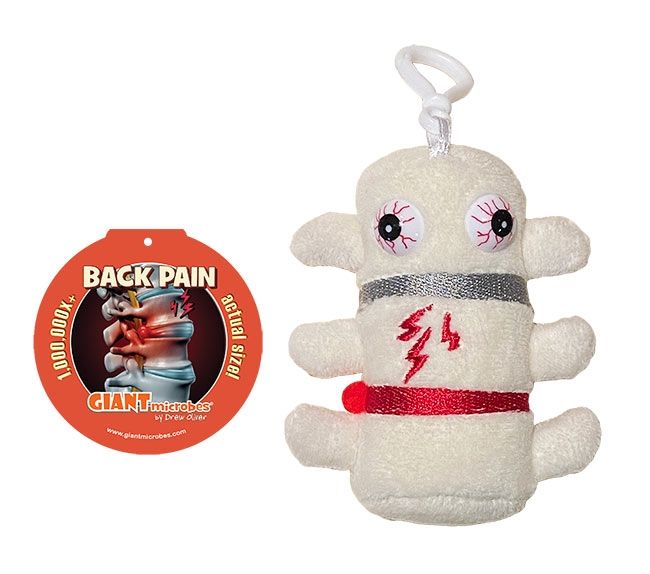Back Pain Key Chain
Back Pain mini microbe (3.5") includes mini-tag and key chain clip.
Product Details
Additional Information
| Sizes | Giantmicrobes are based on actual microbes, cells, organisms and other critters, only 1,000,000 times actual size! Gigantic (GG) 16-24" XL (XL) 10-15" Original (PD) 5-8" Keychain (KC) 2-4" with clip |
|---|---|
| Materials | Plush from all new materials. Stuffed with polyester fiber fill. Surface washable: sponge with water & soap, air dry. |
| Packaging | Each plush microbe includes a printed card with fun, educational and fascinating facts about the actual microbe or cell. |
| Safety | Every product meets or exceeds U.S. and European standards for safety. For ages 3 and up. |
All about Back Pain Key Chain
FACTS: You are not alone if you suffer from back pain. Among the top reasons for doctor visits, back pain has reached epidemic proportions and it can be agonizing. As many as 80% of the population will confront at least one episode.
The physical pain people suffer involves the complex system of nerves, muscles, tendons, cartilage, joints and bones. The causes of back pain range from infection and fracture to arthritis and other chronic conditions. Overwork, poor posture and mistreatment are also major culprits. The result is often a bulging spinal disc. The vertebrae of the spinal column have hollow cores to protect the nerves inside. Vertebrae are separated by flexible discs filled with a soft, jelly-like substance that provides cushioning and balance to the spine. When the harder “skin” of the disc is torn in an accident or by abrasion, the inner disc “jelly” pushes the skin of the disc outward. In a ruptured or herniated disc, this jelly leaks out. In such extreme cases the discs are no longer cushioned and the jelly itself can cause inflammation and pain to the surrounding nerves.
Medical experts now view chronic pain as a disease in its own right. Over time it changes brain patterns associated with physical sensations as well as sleep, thought and emotion. Annual spending on treatments now tops $100 billion. The prevalence of back and other chronic pain has produced a secondary public health crisis, widespread opioid addiction. Hopefully next-generation painkillers and therapies, such as stress reduction and biofeedback, will bring better relief.









